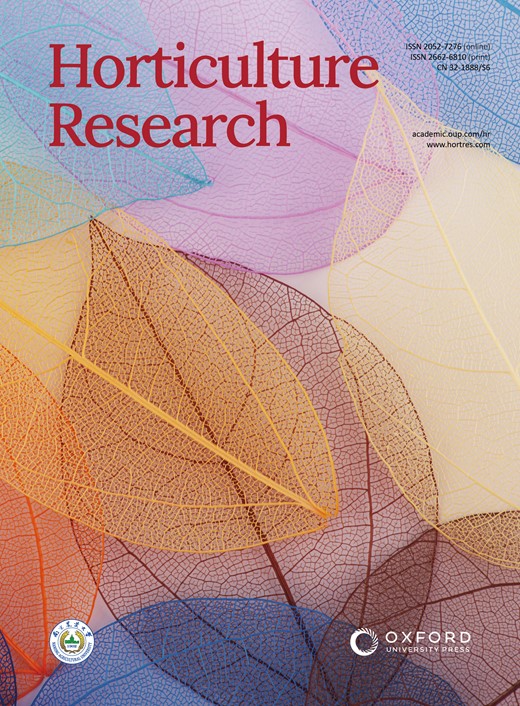Fine mapping and identification of candidate genes associated with powdery mildew resistance in melon (Cucumis melo L.)
IF 8.7
1区 农林科学
Q1 Agricultural and Biological Sciences
引用次数: 0
Abstract
Powdery mildew, a common disease of many major crop species, including melon (Cucumis melo L.), affects plant growth and fruit quality, and seriously reduces production. Using a combined morphological and molecular approach, we attribute the powdery mildew pathogen that naturally occurs in melon to Podosphaera xanthii, and specifically to physiological race 1. An investigation into the genetic basis of powdery mildew resistance in melon using the resistant accession “PI 164637” and susceptible counterpart “HDZ” reveals dominant inheritance of PM resistance at the seedling stage, supported by F2 and backcross population segregation ratios. Adult plant assessments indicate a major gene with an additive effect for powdery mildew resistance. Bulk segregant analysis coupled with high-throughput sequencing identified a significant quantitative trait locus on chromosome 6 that is associated with powdery mildew resistance. Genetic mapping narrowed down the candidate region to 63.5 kb using InDel molecular markers, harboring 12 candidate genes. The marker chr06_indel_5047127 demonstrated high accuracy in screening powdery mildew resistance in a F2 segregating population and 30 inbred lines as natural populations. Functional annotation and expression analysis of candidate genes revealed that MYB transcription factor MELO3C006700, GATA transcription factor MELO3C028829 and heparanase-like protein MELO3C006697 are promising candidate genes for powdery mildew resistance in melon. The genetic architecture underlying this resistance in melon offers valuable insights for breeding programs, and the identified markers, especially chr06_indel_5047127, may enable practical applications for marker-assisted selection in developing powdery-mildew-resistant melon varieties.甜瓜(Cucumis melo L.)抗白粉病候选基因的精细图谱绘制与鉴定
白粉病是包括甜瓜(Cucumis melo L.)在内的许多主要作物品种的常见病,会影响植株生长和果实品质,严重降低产量。利用形态学和分子学相结合的方法,我们将甜瓜中自然发生的白粉病病原体归因于 Podosphaera xanthii,特别是生理种族 1。利用抗性品种 "PI 164637 "和易感品种 "HDZ "对甜瓜白粉病抗性的遗传基础进行的调查显示,甜瓜白粉病抗性在幼苗期为显性遗传,并得到 F2 和回交群体分离比的支持。成株评估表明,抗白粉病的主要基因具有加性效应。大量分离分析与高通量测序相结合,在 6 号染色体上发现了一个与白粉病抗性相关的重要数量性状基因座。基因图谱利用 InDel 分子标记将候选区域缩小到 63.5 kb,其中包含 12 个候选基因。标记chr06_indel_5047127在F2分离群体和作为自然群体的30个近交系中筛选白粉病抗性时表现出很高的准确性。候选基因的功能注释和表达分析表明,MYB 转录因子 MELO3C006700、GATA 转录因子 MELO3C028829 和类肝糖蛋白 MELO3C006697 是甜瓜白粉病抗性的候选基因。甜瓜抗白粉病的遗传结构为育种计划提供了有价值的见解,已鉴定的标记,尤其是chr06_indel_5047127,可能会在开发抗白粉病甜瓜品种的标记辅助选择中得到实际应用。
本文章由计算机程序翻译,如有差异,请以英文原文为准。
求助全文
约1分钟内获得全文
求助全文
来源期刊

Horticulture Research
Biochemistry, Genetics and Molecular Biology-Biochemistry
CiteScore
11.20
自引率
6.90%
发文量
367
审稿时长
20 weeks
期刊介绍:
Horticulture Research, an open access journal affiliated with Nanjing Agricultural University, has achieved the prestigious ranking of number one in the Horticulture category of the Journal Citation Reports ™ from Clarivate, 2022. As a leading publication in the field, the journal is dedicated to disseminating original research articles, comprehensive reviews, insightful perspectives, thought-provoking comments, and valuable correspondence articles and letters to the editor. Its scope encompasses all vital aspects of horticultural plants and disciplines, such as biotechnology, breeding, cellular and molecular biology, evolution, genetics, inter-species interactions, physiology, and the origination and domestication of crops.
 求助内容:
求助内容: 应助结果提醒方式:
应助结果提醒方式:


